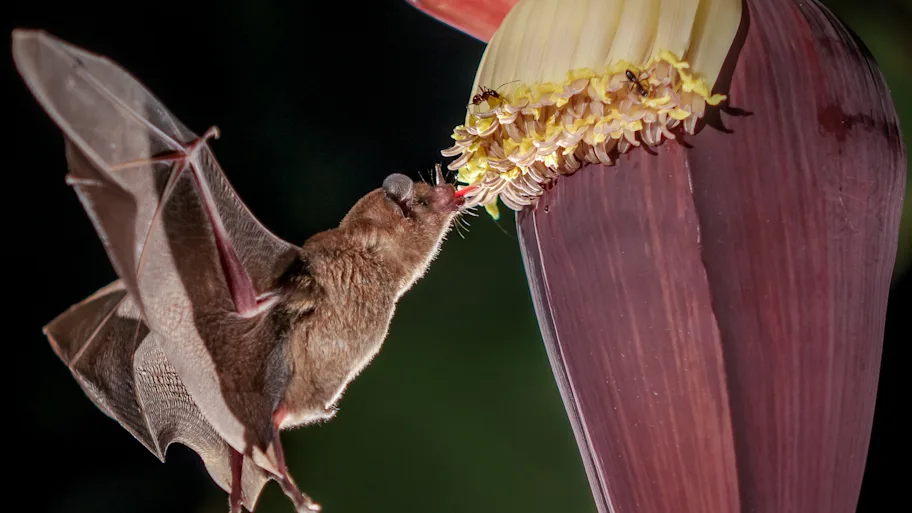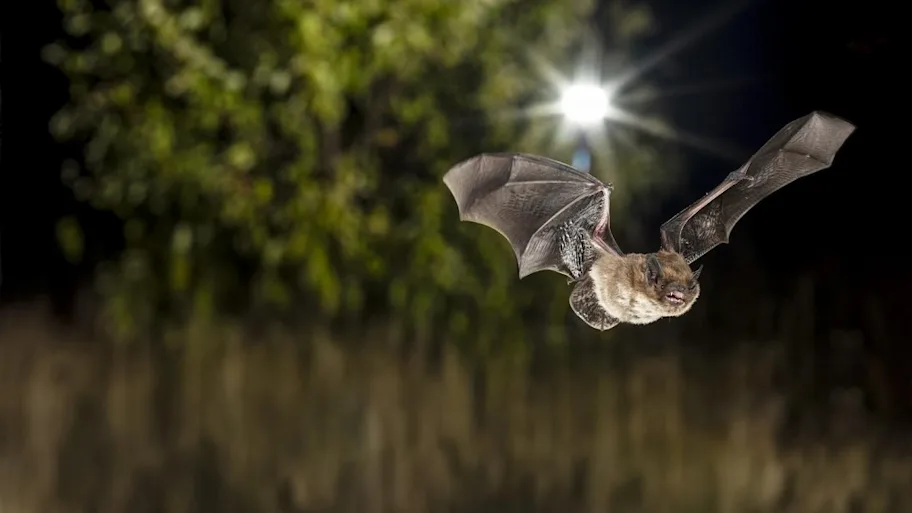
- Science News
- Featured news
- Evolution of bat wings and calls through ‘foraging syndromes’ allows diversity to flourish
Evolution of bat wings and calls through ‘foraging syndromes’ allows diversity to flourish
By Mischa Dijkstra, Frontiers science writer

Egyptian slit-faced bats, Nycteris thebaica
In a new study, scientists show that the wing shape and the echolocation frequency of bats are tightly linked across species. This pattern could only be identified because of the large dataset in the present study, which allowed the authors to look beyond the effect of bat family on these traits. The results mean that wing shape and echolocation frequency have jointly evolved in response to foraging ecology, yielding an optimal combination of traits or ‘foraging syndrome’ in each habitat.
Bats are an evolutionary success story. With approximately 1,400 species living today, they thrive in every environment except the polar regions. They come in a remarkable range of sizes, from the golden-crowned flying fox with a mass of 1.2 kg and a wingspan of 171 cm, to Kitti's hog-nosed ‘bumblebee’ bat with a mass of 2 g and a wingspan of 33 cm. The frequencies that bats emit during echolocation are also highly variable, ranging from 11 kHz to 212 kHz. But what has driven the evolution of this extraordinary diversity?
“Here we show with that among bat species, there is a close correspondence between wing shape and the frequency of their echolocation vocalizations. This pattern wasn’t found in earlier studies because it’s hidden among the variation due to family,” said Dr Bo Luo, a researcher at China West Normal University and a corresponding author on the study, which is published in Frontiers in Ecology and Evolution.
“And importantly, both are tightly linked to foraging ecology – the preferred habitat type of a species and how it catches prey there.”
Evolutionary trade-offs
Scientists already knew that different wing shapes are optimal for bats in certain environments: for example, short, round wings are more maneuverable in confined spaces, while long, pointed wings are best for fast flight over long distances. Echolocation also requires trade-offs: calls with long duration or high frequency are more costly to produce, but are more effective at detecting tiny prey among environmental clutter. So how are these competing demands balanced?
Luo and colleagues gathered published data on 152 species of bats in 15 families: each species’ body mass, the duration and peak frequency of its echolocation calls, the body mass divided by the wing area (‘wing loading’) and the wing ‘aspect ratio’ – the square of the wingspan divided by wing area. As a proxy for ecology, they assigned each species to one of five ‘foraging guilds’. For example, edge-space trawling foragers scoop up insects or small fish from water surfaces with their tail membrane and feet, while open-space aerial foragers catch insects on the wing in the open air.
Strong effect of family
The authors found that echolocation peak frequency and wing morphology are strongly dependent on bat family. This means that any other evolutionary patterns are likely to remain hidden, unless the range of families and species in the sample is large. And it’s the large sample of the present study which revealed that after differences between families are taken into account, peak frequency in echolocation and wing shape tend to be positively associated with each other.
Corresponding author Dr Jiang Feng, a professor at Northeast Normal University, said: “Our results show that peak frequency and wing shape are linked: for example, bat species that hunt in open spaces tend to have long, pointed wings, and to produce long echolocation calls of low frequency.”
“In contrast, species that hunt in edge spaces tend to have short, round wings, and to emit short calls of intermediate frequency. And species that forage in narrow spaces tend to have short, round wings and high-frequency calls.”
Distinct foraging syndromes
The authors concluded that echolocation parameters and wing shape haven’t evolved independently from each other. Rather, they both evolved as dictated by each species’ foraging ecology. For each type of habitat, there is a unique optimal evolutionary solution – a foraging syndrome – that matches wing shape and echolocation traits to foraging mode. These syndromes have evolved repeatedly in each family.
“We demonstrate that foraging ecology drives the correlated evolution of wing morphology and echolocation calls in extant bats. This doesn’t necessarily mean that flight and echolocation evolved simultaneously. To answer the question of which came first, we need research that explores similarities in forelimb shape, the auditory system, and associated traits between extant bats and fossils of bat progenitors,” said Luo.
REPUBLISHING GUIDELINES: Open access and sharing research is part of Frontiers’ mission. Unless otherwise noted, you can republish articles posted in the Frontiers news site — as long as you include a link back to the original research. Selling the articles is not allowed.






